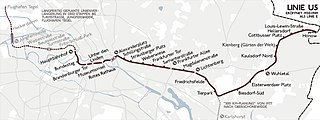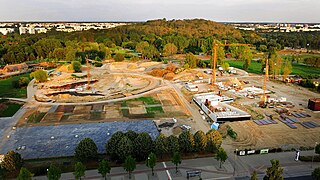


Erholungspark Marzahn is a public park in Marzahn, Berlin. It was opened on 9 May 1987 as Berliner Gartenschau. The total area encompasses more than 100 hectares (250 acres).



Erholungspark Marzahn is a public park in Marzahn, Berlin. It was opened on 9 May 1987 as Berliner Gartenschau. The total area encompasses more than 100 hectares (250 acres).
In 1991, the park was renamed to Erholungspark Marzahn. In October 2000, the Chinese garden is opened as a part of Gärten der Welt (Gardens of the World). This was followed by other gardens, including Oriental, Italian, Balinese, Korean, and Japanese. In 1995, it welcomed 132,000 visitors. By 2007 the number has increased to 650,000.
In 2018 the English garden was open in the park.
The park was chosen as the site of the Internationale Gartenausstellung 2017 (IGA 2017), an international horticultural exhibition. [1]

Pura Tri Hita Karana is a functioning Hindu temple located in the Balinese Garden of the park. It is one of the few Hindu temples of Balinese architecture built outside Indonesia. [2]
| Theme | Area | Opened |
|---|---|---|
| Chinese garden | 27,000 m2 (290,000 sq ft) | 15 October 2000 |
| Japanese garden | 2,700 m2 (29,000 sq ft) | 30 April 2003 |
| Balinese garden | 500 m2 (5,400 sq ft) | 18 December 2003 |
| Oriental garden | 6,100 m2 (66,000 sq ft) | 7 July 2005 |
| Korean garden | 4,000 m2 (43,000 sq ft) | 31 March 2006 |
| Italian garden | 3,000 m2 (32,000 sq ft) | 31 May 2008 |
| English garden | 2018 | |
Nearest metro station is Kienberg (Gärten der Welt), on the U5 line. Named "Neue Grottkauer Straße" until 2016, it was renamed in that way for the IGA 2017. The station is also the eastern terminus of the IGA Cable Car (German : IGA-Seilbahn), a 1.5 km-long aerial tramway line serving and crossing the park, built for the expo. [3] [4]

U5 is a line on the Berlin U-Bahn. It runs from Hauptbahnhof in Mitte eastwards through Alexanderplatz, Friedrichshain, Lichtenberg and Friedrichsfelde, surfaces in Biesdorf-Süd to pass Kaulsdorf and Hellersdorf above ground and finally reaches city limits at Hönow.

Balinese Hinduism is the form of Hinduism practiced by the majority of the population of Bali. This is particularly associated with the Balinese people residing on the island, and represents a distinct form of Hindu worship incorporating local animism, ancestor worship or Pitru Paksha, and reverence for Buddhist saints or Bodhisattava.

Marzahn is a locality within the borough of Marzahn-Hellersdorf in Berlin. Berlin's 2001 administrative reform led to the former boroughs of Marzahn and Hellersdorf fusing into a single new borough. In the north the Marzahn locality includes the neighbourhoods of Bürknersfelde and Ahrensfelde, an overbuilt strip of land which once had belonged to the Brandenburg municipality of Ahrensfelde and was incorporated into Berlin in 1990.

The Haus der Kulturen der Welt in Berlin is Germany's national center for the presentation and discussion of international contemporary arts, with a special focus on non-European cultures and societies. It presents art exhibitions, theater and dance performances, concerts, author readings, films and academic conferences on Visual Art and culture. It is one of the institutions which, due to their national and international standing and the quality of their work, receive funding from the federal government as so-called "lighthouses of culture", from the Federal Minister of State for Culture and the Media as well as from the Federal Foreign Office. As a venue and collaboration partner, HKW has hosted festivals such as the transmediale, curatorial platforms, biennials such as the Berlin Documentary Forum, and mentorship programs such as Forecast. Since 2013, its interdisciplinary elaboration on the Anthropocene discourse has included conferences, exhibitions, and other artistic formats performed together with philosophers, scientists, and arstists, such as Bruno Latour and Hans Joachim Schellnhuber.

Wuhletal is a railway station in the Marzahn-Hellersdorf district of Berlin. It is served by the S-Bahn line and the U-Bahn line .

Kienberg is a station on the U-Bahn in the German capital city of Berlin. It is located on the line.

Paradestraße is a Berlin U-Bahn station on the line. It was opened in 1927 as Flughafen (airport) and at that time provided the world's first direct connection between a metro system and an airport.

Hinduism is a minority religion in Germany. It is practised by 0.1% of the population of Germany. There are approximately 100,000 Hindus living in Germany.

The Britzer Garten is a large park in Berlin, named after Britz, a neighborhood of the borough of Neukölln. It was constructed for the Bundesgartenschau 1985, in order to provide a new landscape park to the citizens in the southeast of West-Berlin, who were at that time cut off from the surrounding countryside.

The Vorderasiatisches Museum is an archaeological museum in Berlin. It is in the basement of the south wing of the Pergamon Museum and has one of the world's largest collections of Southwest Asian art. 14 halls distributed across 2,000 square meters of exhibition surface display southwest Asian culture spanning six millennia. The exhibits cover a period from the 6th millennium BCE into the time of the Muslim conquests. They originate particularly from today's states of Iraq, Syria and Turkey, with singular finds also from other areas. Starting with the Neolithic finds, the emphasis of the collection is of finds from Sumer, Babylonia and Assyria, as well as northern Syria and eastern Anatolia.

Bus transport is the oldest public transport service in Berlin, the capital city of Germany, having been introduced in 1846. Since 1929, services have been operated by the Berlin Transport Company, although during the Cold War-era division of the city they operated in West Berlin only. BVG's fleet consists of 1,300 vehicles, which cover 300,000 kilometres per day.

A pura is a Balinese Hindu temple, and the place of worship for adherents of Balinese Hinduism in Indonesia. Puras are built in accordance to rules, style, guidance and rituals found in Balinese architecture. Most puras are found on the island of Bali, where Hinduism is the predominant religion; however many puras exist in other parts of Indonesia where significant numbers of Balinese people reside. Mother Temple of Besakih is the most important, largest and holiest temple in Bali. Many puras have been built in Bali, leading it to be titled "the Island of a Thousand Puras".

Berlin is recognized as a world city of culture and creative industries. Numerous cultural institutions, many of which enjoy international reputation are representing the diverse heritage of the city. Many young people, cultural entrepreneurs and international artists continue to settle in the city. Berlin has established itself as a popular entertainment center in Europe.

Köllnischer Park is a public park located near the River Spree in Mitte, Berlin. It is named after Cölln, one of the two cities which came together to form Berlin; the park location was originally just outside it. Approximately 1 hectare in area, the park came into existence in the 18th and 19th centuries on the site of fortifications. It was redesigned as a public park in 1869–73 and was further modified in the 20th century with the addition of first a bear enclosure, the Bärenzwinger, and later a permanent exhibition of sculpture, the Lapidary. The park is a registered Berlin landmark.

The International horticultural exposition 1993 was held at the Baden-Wuerttemberg state capital, Stuttgart, Germany. The IGA was within the past 54 years already the fifth major horticultural show which hosted Stuttgart in the 20th century. Recognised by the Bureau International des Expositions (BIE), the Expo ran from April 23, 1993, to October 17, 1993. Held at Wartenberg and Killesberg parks, the goal was to be visually and functionally integrated with the two challenging terrains, the Wartberg and the Leibfriedsche garden. This was achieved. The long Advised long-term goal to pull a U-shaped green belt around the city, which became a reality. The mascot of the horticultural show called "Flori", a bird with a cowboy hat. Overall, 7.3 million people visited the garden show. Thus the expectations of the city fathers were exceeded, because it had been expected a turnout of 7 million.

The Internationale Gartenausstellung 2017 was an international horticultural exhibition that took place in Berlin, Germany, in 2017.
International Garden Expo 83 was a garden festival containing 170 exhibition contributors. The international horticultural exposition was recognised by the Bureau International des Expositions (BIE) and held from April 28 to October 9, 1983, at Westpark in Munich, Germany. Ralph Siegel wrote the Flower Serenade as official song of the exhibition; it was recorded by Hugo Strasser and his orchestra. The German Federal Post Office issued a special stamp with a stylized flower.

The IGA Cable Car, also known as Berlin Cableway, IGA Ropeway or IGA Cableway, is a 1.58 km (0.98 mi)-long gondola lift line serving and crossing the Erholungspark Marzahn in Berlin, capital of Germany. Built for the Internationale Gartenausstellung 2017, an international horticultural exhibition, it is the first cableway opened in the German capital.
| Wikimedia Commons has media related to Erholungspark Marzahn . |